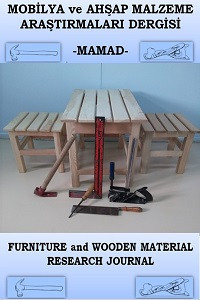Kolofan reçinesi katkılı borlu bileşiklerle emprenye edilen Sarıçam (Pinus Sylvestris Lipsky) odununun yanma özellikleri
Bu çalışma, kolofan reçinesi (C19H29COOH) katkılı borlu bileşiklerle (Boraks (Na2B4O710H2O) + Borik asit (H3BO3) - ağırlıkça % 50:50) emprenye edilmiş Sarıçam (Pinus Sylvestris Lipsky) odununun yanma özelliklerinin belirlenmesi amacıyla yapılmıştır. Bu amaçla, sarıçam deney örnekleri kolofan reçinesi katkılı borlu bileşiklerle ASTM D 1413 standardı esaslarına göre daldırma metodu ile emprenye edilmiştir. Emprenye edilen deney örneklerinin yanma özellikleri ASTM E 160 standardı esaslarına göre belirlenmiştir. Araştırmanın bir parçası olarak, özellikle farklı konsantrasyonlarda hazırlanan borlu bileşikler ile emprenye edilmiş ahşap malzemenin yanma direncini araştırmak için 6 farklı kombinasyon kullanılmıştır. Kolofan reçinesi ilavesiyle borlu bileşiklerin tutunma performansının ve yıkanma direncinin arttığı tespit edilmiştir. Kolofan katkılı borlu bileşiklerle emprenye edilen deney örneklerinde, kontrol örneklerine göre alev kaynaklı yanma (Fsc) sıcaklığı, yanma süresi ve ağırlık kaybı oranlarında düşüş görülmüştür. Kolofan reçinesi, ahşabın cinsine ve kullanım alanına bağlı olarak borlu bileşikler içinde katkı maddesi olarak tercih edilebilir.
Anahtar Kelimeler:
kolofan, yanma, borlu bileşikler
Combustion properties of Scots pine (Pinus sylvestris Lipsky) wood impregnated with boron compound doped colophony
The aim of this study was to investigate the combustion properties of Scots pine (Pinus sylvestris Lipsky) wood impregnated with boron compound (borax (Na2B4O710H2O), boric acid (H3BO3) w/w 50:50%) doped colophony (C19H29COOH). For this aim, Scots pine wood samples were impregnated with boron compound doped colophony by the method of medium-term dipping according to ASTM D 1413 and producers’ definition. Combustion properties of samples after impregnated process were determined according to ASTM E 160. As a part of the research, 6 different combination and contents of impregnation materials have been used in order to especially investigate resistance against combustion of wood material treated with boron compounds in different concentrations. Consequently, retention performance and leaching resistance of boron compounds can be increased through colophony addition. Impregnation materials with colophony decreased the flame sourced combustion (Fsc) temperatures depending on kind of impregnation material, combustion period and weight loss ratio of the test samples decreased in comparison to the control samples. Colophony can be preferred in impregnation with boron compounds depending on kind of wood and using area.
Keywords:
Colophony Boron compounds, Combustion, Impregnation,
___
- ASTM D 1413-99 (2005), Standard method of testing wood preservatives by laboratory soil block cultures, Annual Book of ASTM Standards, West Conshohocken, PA.
- ASTM E 160-50 (1975), Standard test method for combustible properties of treated wood by the crib test, Annual Book of ASTM Standards, West Conshohocken, PA.
- Ayar, S. (2008), Determination of impacts of pressure and soaking period on penetration of impregnation liquids into the wood materials, Scientific Expertise Thesis, Karabük University Institute of Applied Science, Turkey
- Baysal, E. (2003), Combustion properties of scots pine wood impregnated with boron compounds and natural tanning materials, Erciyes University Journal of Institute of Applied Science, Turkey, p. 59
- Baysal, E., Sonmez A., Çolak, M. and Toker, H., (2006), Amount of leachant and water absorption levels of wood treated with borates and water repellents, Bioresource Technology 97, 2271–2279
- Giachi, G., Capretti, C., Donato I., Macchioni, N. and Pizzo B., (2011), New trials in the consolidation of waterlogged archaeological wood with different acetone-carried products, Journal of Archaeological Science 38, 2957-2967.
- Kartal, S.N. and Imamura, Y. (2004), Using boron compounds as impregnation material in wood materials and composites, III. International Boron Symposium. Eskişehir, Turkey, p. 333-335.
- Keskin, H., Ertürk, N.S., Çolakoglu, M.H. and Korkut S. (2013), Combustion properties of rowan wood impregnated with various chemical materials, International Journal of Physical Sciences (IJPS) 8(19), 1022-1028
- Mohareb, A. (2005), Development of leach-resistant boron compounds for wood protectıon ın exterior applications in Egypt. Ph.D. Thesis. Gent University.
- Obanda, D., Shupe, T. and Barnes, H.M. (2008), Reducing leaching of boron-based wood preservatives – A review of research, Bioresource Technology 99, 7312–7322
- Ors, Y., Atar M. and Peker H. (1999.a), The effect of some boron compounds and water repellents on the fire resistance properties of scotch pine wood, Tr. J. of Agriculture and Forestry 23, 501-509
- Ors, Y., Atar, M. and Peker, H. (1999.b), The effects of different preservation chemicals and finishing on wood combustion properties in Pinus sylvestris L. and Castanea sativa Mill., Tr. J. of Agriculture and Forestry 23, 541-549
- Ors, Y. and Keskin, H. (2001), Agaç Malzeme Bilgisi, Gazi Üniversitesi yayın no. 2000/352, Atlas yayıncılık, İstanbul, Türkiye.
- Ors, Y., Atar M., Keskin, H. and Colakoglu, H.M. (2006), Impacts of impregnation with boron compounds on the surface roughness of some woods and varnished surfaces, J. of Applied Polymer Science (JAPS), 102(5), 4952-4954.
- Ors, Y. and Keskin, H. (2008), Wood material technology, Gazi Publishing, Ankara, p. 141-151.
- Temiz, A., Gezer E.D., Yıldız, U.C. and Yıldız, S. (2008), Combustion properties of alder (Alnusglutinosa L.) Gaertn. subsp. barbata (C.A. Mey) Yalt.) and southern pine (Pinus sylvestris L.) wood treated with boron compounds, Construction and Building Materials 22, 2165–2169
- TS 2476 (1976), Sampling methods for physical and mechanical tests of wood materials and general features, TSE, Ankara, Turkey.
- Unger, A., Schniewind A.P. and Unger W. (2001), Conservation of wood artifacts, Handbook, Published by Springer, USA
- Uysal, B. (1997), The impacts of various chemical materials on combustion resistance of wood material, Ph.D. Thesis, Gazi University Institute of Applied Sci., Ankara, 96-99.
- Yayın Aralığı: Yılda 2 Sayı
- Başlangıç: 2018
- Yayıncı: Bekir Cihad BAL
Sayıdaki Diğer Makaleler
Mustafa UĞUZ, Eyüp AKSOY, Hakan KESKİN
Türkiye’de mobilya sektörüne iş gücü sağlamada mesleki eğitim merkezlerinin önemi
Bekir Cihad BAL, Samet ARTUNAL, Fevzi DUMANOĞLU
Ürün kalitesinin çok kriterli karar verme ile sınıflandırılması: mobilya işletmesi örneği
MDFLAM üretiminde pres kütle sıcaklık farkının düzlemden sapma üzerine etkisi
